Nuclear Tourism: When atomic tests were a tourist attraction in Las Vegas, 1950s

At night, the glow of the bombs lit up the sky, and mushroom clouds could be spotted rising over the horizon during the day.
In classical American fashion, fear was not the only reaction. Vegas started becoming a destination for a certain type of people — Nuclear Tourists.
Let’s roll back to understand why Nevada was selected for nuclear testing . The Yucca Flats of Nevada was located in the center of the American wasteland, making it the perfect place for nuclear testing. First off by being located in the middle of the desert, it created very few threats to surrounding homes.
Additionally, over 87% of the Nevada area is owned by the federal government. It had vast available lands, sunny weather, and good rail connections.
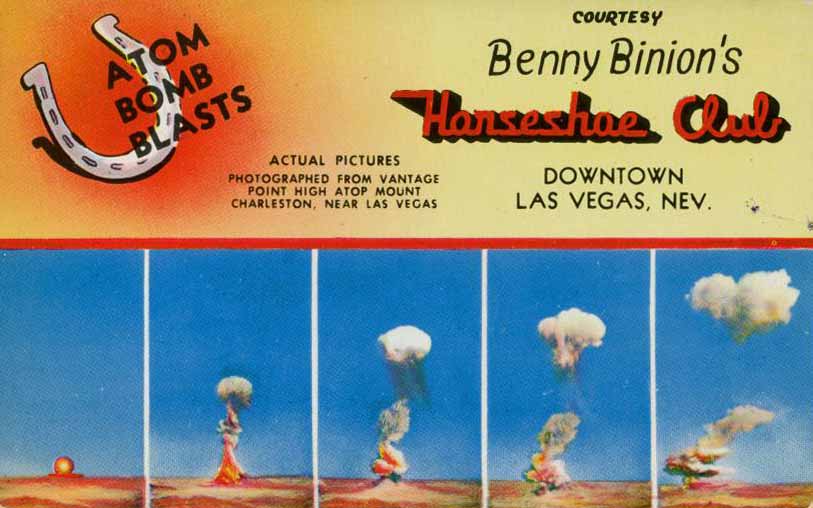
A Horseshoe Club advertisement touting its excellent views of nuclear tests.
The nuclear detonations provided a source of spectacles and entertainment for people who did live in this area. As a result, Vegas began to experience a new influx of people from across the country who would travel thousands of miles in order to catch a glimpse of this new show.
Soon after Las Vegas was transformed from the original city of 25,000 people to the world-renown spectacle of three million people.
Journalists everywhere began jumping on this new exciting event, and the topic of atomic tourism became the biggest headliner everywhere.
Even writers in the New York Times began referring to it as, “the non- ancient but nonetheless honorable pastime of atom-bomb watching.”

Witness the power of the Atomic Bomb. A mere $3 for a safe viewing distance.
Inherently speaking, Vegas was designed for showmanship. Visitors are encouraged to live in the moment and focus on what is in front of them, by masking the individual from all reminders of time and location.
Their motto: pay attention to what is in front of you. Therefore by taking advantage of this concept and its psychological effect, landowners and industry owners began turning these tests into spectacles of themselves.
The Vegas Chamber of Commerce promoted in advance the dates and times for these tests. Calendars and community announcements would be published months in advance for tourists to plan and enjoy the spectacle of the mushroom cloud.
Photos of these events began circulating across news sources everywhere and bomb-watching became such a rage that thrill-seeking tourists would make sure to get the closest spot possible to the ground-zero.
On the eve of detonations, many Las Vegas businesses held “Dawn Bomb Parties.” Beginning at midnight, guests would drink and sing until the flash of the bomb lit up the night sky.

Bombs over Fremont.
However, in addition to these parties, Vegas also capitalized on the nuclear tests by providing itself as a source of relief and nostalgia from the surrounding terror.
Gambling, games, and television were all sources of distraction that provided Vegas guests with an escape from the fear that was surrounding them.
Both Vegas itself and the Yucca Flats of the Nevada Testing Site were turned into tourist attractions of various sorts. The main spectacle of the site to date are the large craters currently scarring the desert surface.
The desert floor is sprinkled with craters of all shapes and sizes, ranging from nuclear warheads to smaller surface-level bombs.
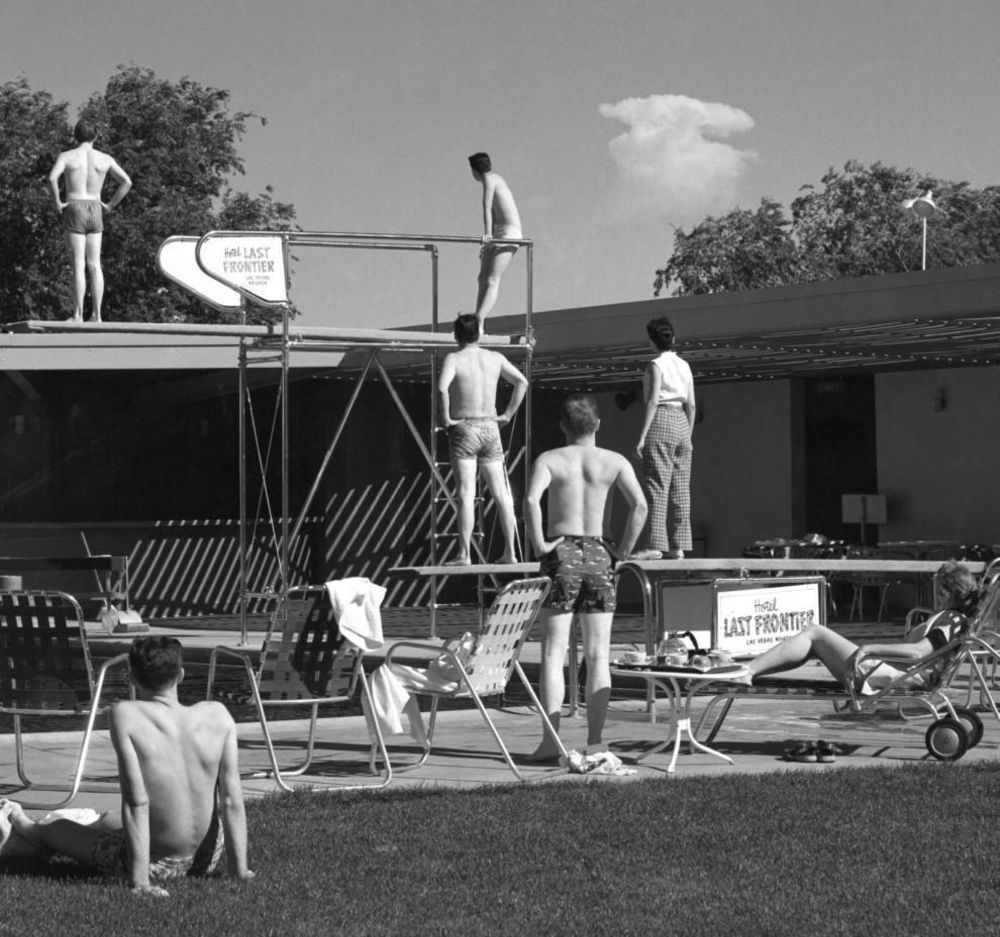
Early morning bathers at a hotel pool in Las Vegas stop to watch the mushroom cloud of an atomic detonation at a test site about 75 miles from the city. May 8, 1953.
One of the more popular craters is Bilby crater, which was created in 1963 by an underground test. Producing about 249 kilotons of explosive power, the blast created a hole that was 1,800 feet wide (550m) and 80 feet (24m) deep and also resulted in an aftershock that was felt all the way in Vegas itself.
Sedan crater is also popular due to its large size. Sitting at about 1280 feet (1280m) wide and 230 feet (70m) deep, a 104 kiloton blast right beneath the surface of the desert floor produced this crater.
The effects compared to that of a 4.75 earthquake moved about 12 million tons of Earth in its passing.
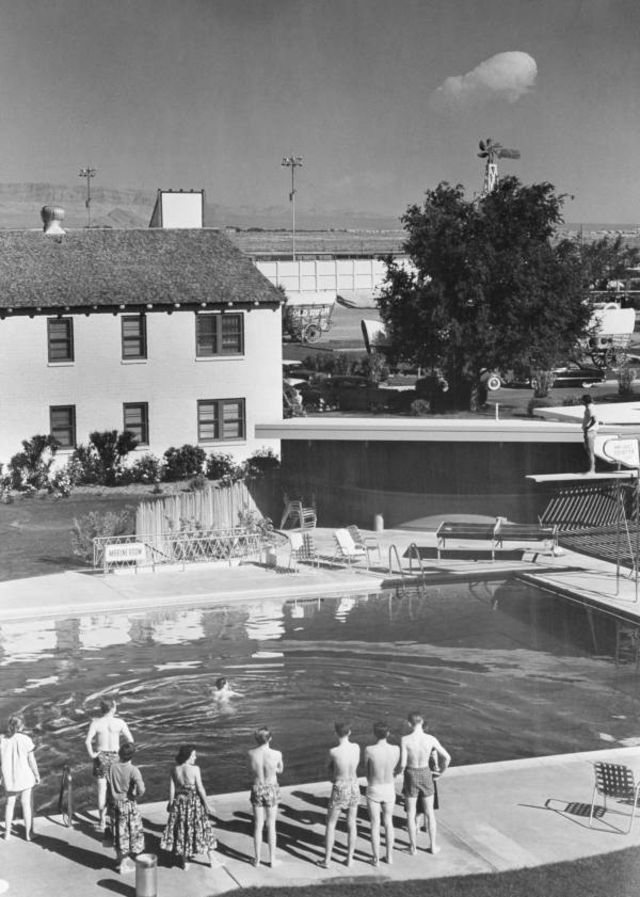
Guests at the Last Frontier hotel in Las Vegas watch the mushroom from a detonation about 75 miles away. May 8, 1953.
One journalist, writing for the Department of State Washington Bulletin, described witnessing the blast: “You put on the dark goggles, turn your head, and wait for the signal. Now — the bomb has been dropped. You wait the prescribed time, then turn your head and look.
A fantastically bright cloud is climbing upward like a huge umbrella…. You brace yourself against the shock wave that follows an atomic explosion.
A heat wave comes first, then the shock, strong enough to knock an unprepared man down. Then, after what seems like hours, the man-made sunburst fades away.”
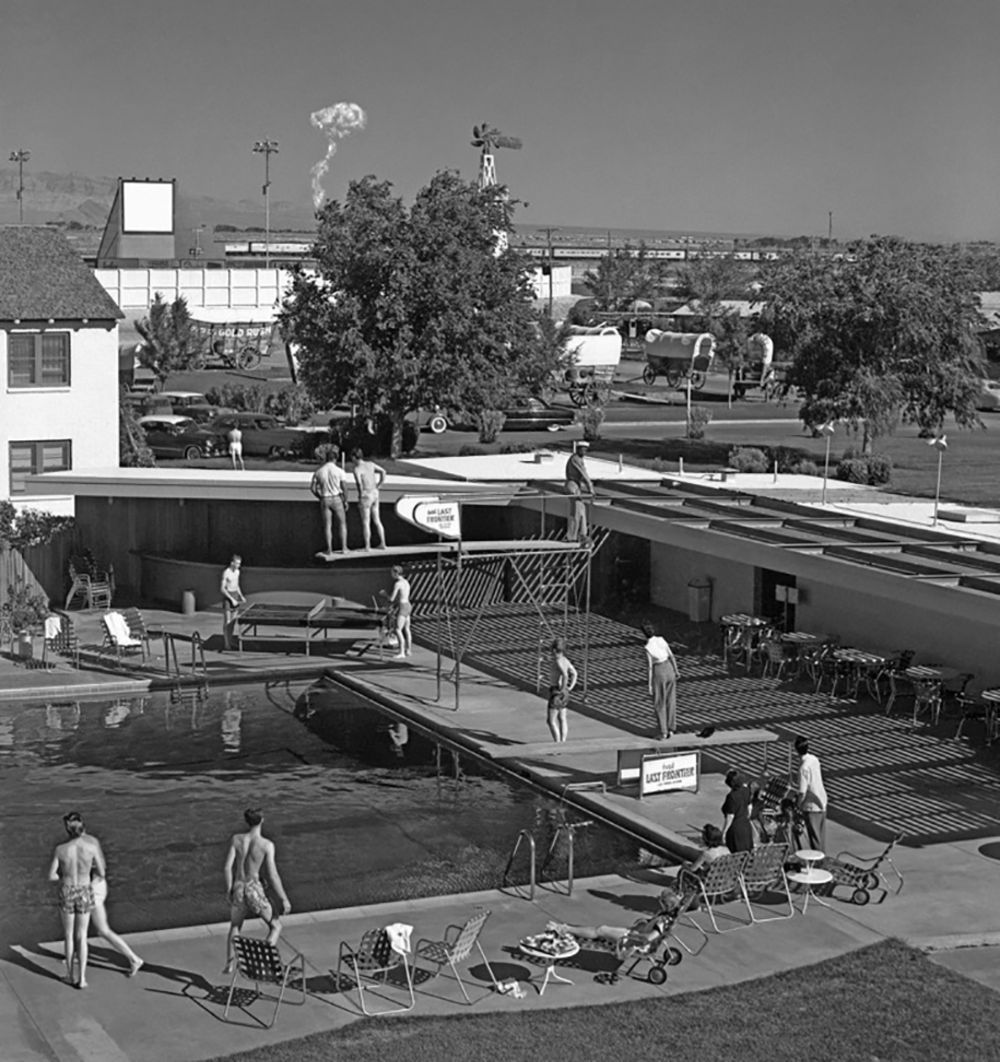
Watching poolside. Nuclear tests were a rather ordinary part of life in Las Vegas.
For twelve years, an average of one bomb every three weeks was detonated, at a total of 235 bombs. Flashes from the explosions were so powerful that they could reportedly be seen from as far away as Montana.
Scientists claimed that the radiation’s harmful effects would have dissipated and been harmless once the shock waves reached Las Vegas, and they scheduled tests to coincide with weather patterns that blew fallout away from the city.
However, as the tests continued, people in northeastern Nevada and southern Utah began complaining that their pets and livestock were suffering from beta particle burns and other ailments; by 1963 the Limited Test Ban was in effect, banning above-ground nuclear testing at the site.
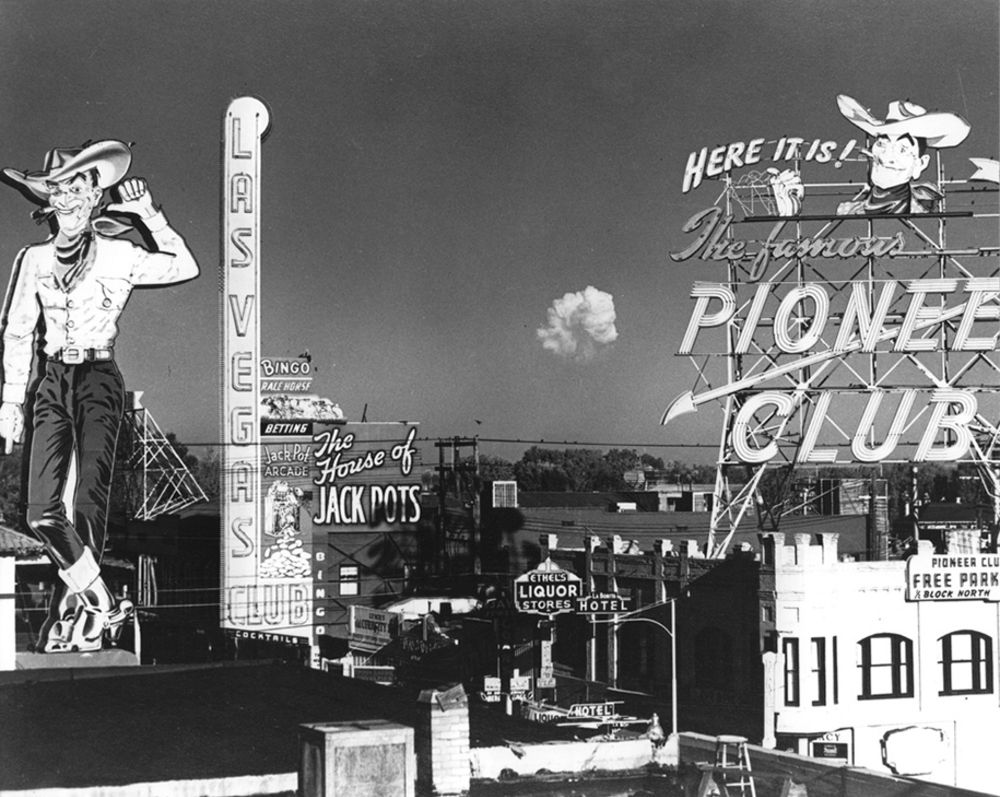
Hotels offered panoramic views of the distant desert skyline for the optimum experience.
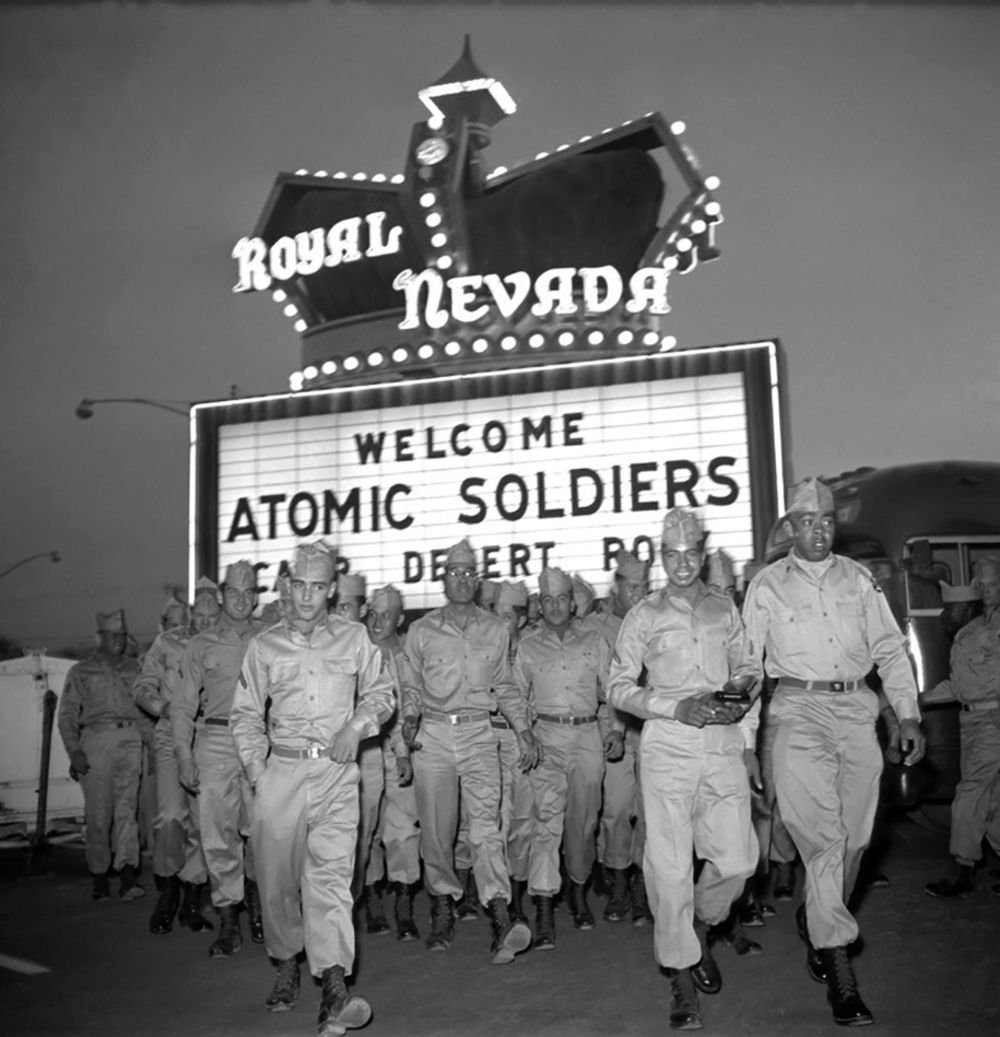
The Nevada Test Site wasn’t just a boom for travelers. The proving ground flooded the area with federal funds, and the site employed close to 100,000 men and women.
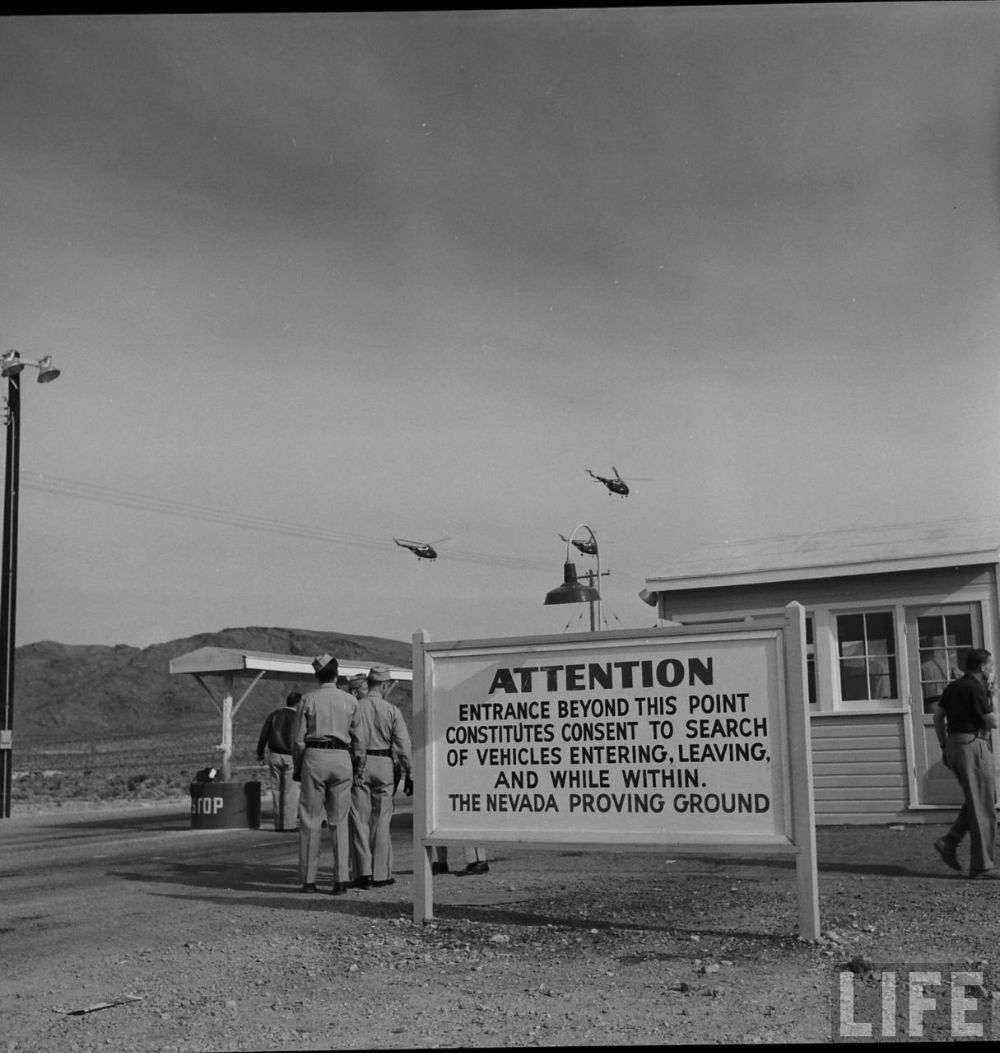
Nevada test site.
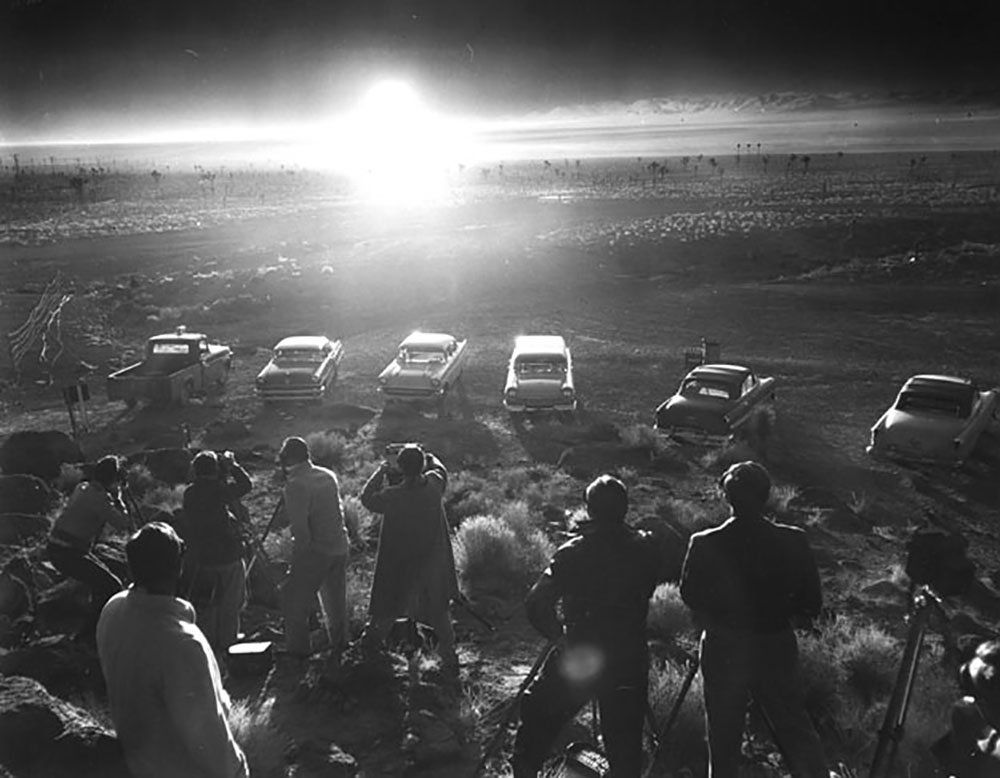
Reporters witness the nuclear test on Frenchman Flat, on June 24, 1957.
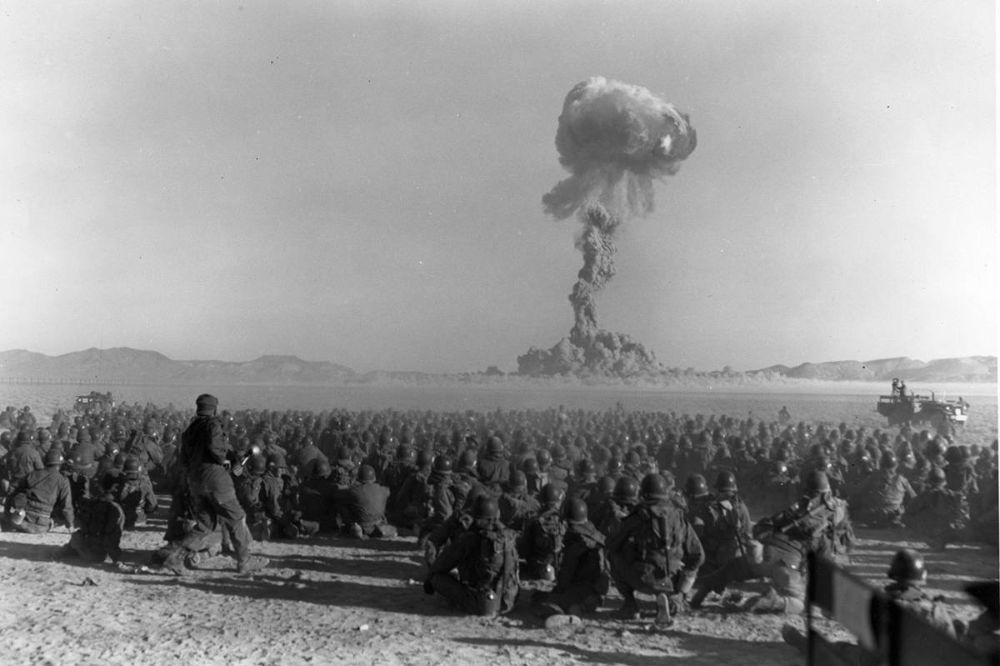
Operation Buster-Jangle – Dog test — with troops participating in exercise Desert Rock I, November 1, 1951. It was the first U.S. nuclear field exercise conducted on land; troops shown are a mere 6 miles from the blast.

Atomic tourists taking in the sites.
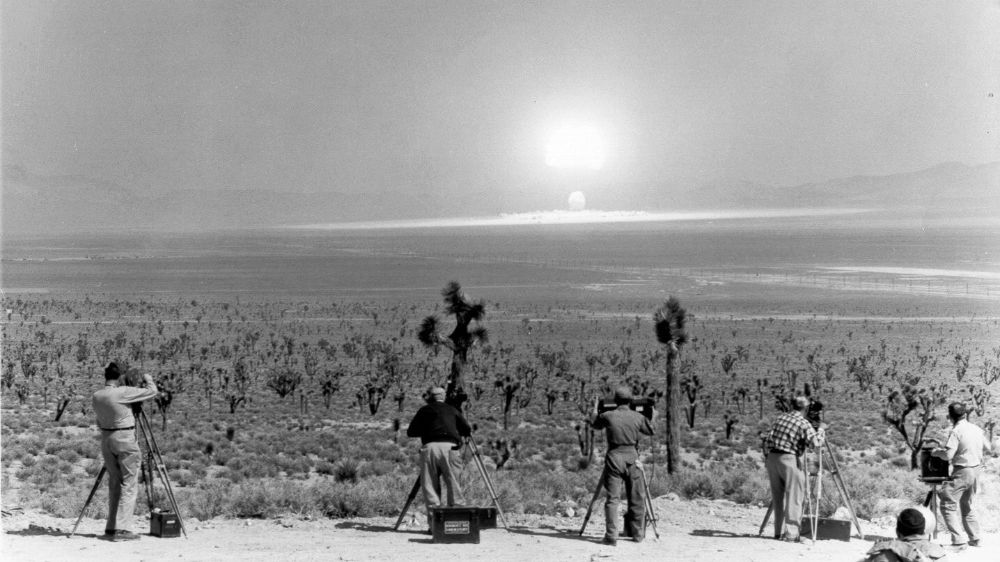
Camera men filming the atomic blast of Wasp Prime Test, during Operation Teapot. Nevada, February 18, 1955.
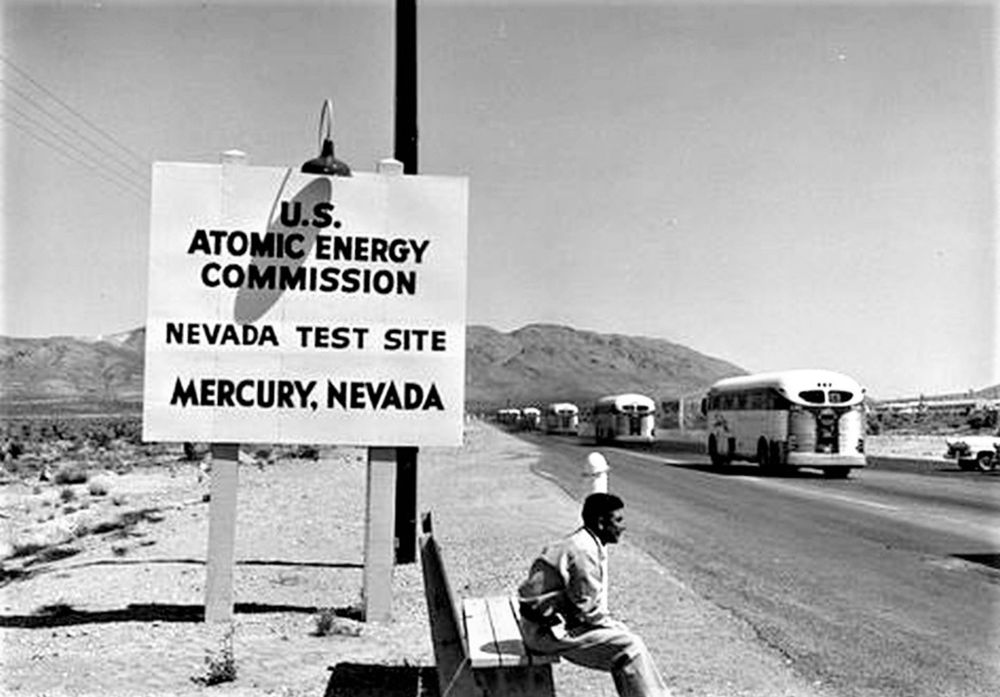
Man sitting near a Nevada Test Site sign, Nevada, United States, 1955 From 1951–1962, Mercury was a town in the Nevada atomic testing site where hundreds of test explosions were conducted.

Watching poolside.

Soldiers at the test site.

Fashion of the atomic age.

The first flash of light generated by an atomic bomb.

Birds-eye view of dozens of craters dotting the Yucca Flats.

A nuclear crater left behind.

Model posing in front of a nuclear cloud.

Miss Atomic Bomb of Sin City.

Photograph of Yucca Flat, covered with craters created by atomic bombs, in the Nevada Test Site.
(Photo credit: Wikimedia Commons / Las Vegas News Bureau / US Army Archives / Atomic Tourism in Las Vegas by Kiana Pancino).
Updated on: September 29, 2022
Any factual error or typo? Let us know.

- svg]:fill-accent-900"> 1.4M
- svg]:fill-accent-900"> 104K
- svg]:fill-accent-900"> 10.6K

How atomic bombs fueled Las Vegas tourism in the 1950s
By Harold C. Hutchison
Updated on Oct 22, 2020 2:15 AM PDT
You would think that nuclear weapons testing and tourism wouldn’t go together. But in fact, tourists who went to Las Vegas to watch the nuclear tests helped fuel the growth of that city in the 1950s.
In the 1950s, the United States carried out over 150 nuclear weapons tests above ground. Some of these tests – particularly the large-scale thermo-nuclear bomb tests like the 1954 Castle Bravo test, which had a 15-megaton yield – were carried out in the Central Pacific. Not exactly accessible to tourists, but well out of the way (an important consideration considering the power of the bombs).

However, in Nevada — where the explosions and subsequent mushroom clouds were visible from Las Vegas — These tests gave that rapidly-growing city’s economy a surprising boost. Many tourists traveled to Vegas hoping they’d see one of these tests take place.
Of course, today, we know about the after-effects of all those explosions, including fallout that leads to cancer and other medical issues for people who were downwind of the nuclear blasts.

Back then, it was seen as just a fancy fireworks display for Sin City residents and tourists on the United States government’s dime. In 1963, the Partial Test Ban Treaty was ratified. That ended the era of above-ground testing, and limited the blasts to underground.
The U.S. continued to carry out underground nuclear tests until 1992, when the Comprehensive Nuclear Test Ban Treaty curtailed nuke blasts. That treaty, however, has still not been ratified by the Senate. Check out this video from the Smithsonian Channel to learn more about Sin City’s nuclear tourism boom (pun intended).
Latest in Wars
How machine guns on world war i biplanes never hit the propeller how machine guns on world war i biplanes never hit the propeller.
By Blake Stilwell
Today in military history: US drops atomic bomb on Nagasaki Today in military history: US drops atomic bomb on Nagasaki
By Team Mighty
How 1950s Las Vegas Sold Atomic Bomb Tests as Tourism
Between 1950 and 1960, the population of Las Vegas grew by 161%--partly due to the burgeoning casino industry. But another reason was a chance to glimpse actual nuclear tests in person. (01:30)

Atomic Tourism In Las Vegas

During the Cold War of the 1950s and early 60s, Nevadans timed their days to watch the U.S. government's nuclear explosions as they tested atomic weapons at the nearby test site, 65 miles outside of Las Vegas. It was a small town back then, but 10,000-pound bombs turned it into something much bigger. Residents of Las Vegas welcomed the atomic testing once they saw the new flux of people moving to the valley – not to mention a new wave of tourists who came to see the blasts.
Vintage posters from Nevada's push for atomic tourism:

Allan Palmer , Director of the Atomic Testing Museum
A Blast from the Past: Atomic Tourism in Las Vegas
by Bruce Rettig | Feb 10, 2020

IT’S EASY TO GET LOST in the wasteland of research. Having worked in tourism marketing for over thirty years, and presently tackling a new writing project with an opening scene set in 1950’s Las Vegas, I tried my best not to get sucked into the fallout of atomic test stories and a bizarre chapter of Nevada history. I mostly failed and found myself spinning deeper into this weird black hole.
I wrote a post a year ago titled, “How I Never Learned to Stop Worrying and Love the Bomb.” It focused on a generation that grew up in the age of nuclear proliferation and the resulting angst and fear of an atomic disaster. Between 1951 and 1992, the U.S. government conducted a total of 1,021 nuclear tests at the Nevada Proving Ground (now named the Nevada Test Site, or NST) sixty-five miles north of Las Vegas. The site earned the nickname, “The most bombed place on Earth.”

Atomic Tourism: Vegas Visitors Watch Nukes Explode Las Vegas is known as the city of lights and, at one time, that light was the glow of a nuclear detonation in the Nevada desert.
Astounding. Are cancer rates higher in Vegas than the rest of the nation?
Thanks for commenting, Frank. I’m not sure about Las Vegas cancer rates (more research!) but I know the fallout areas were/are significantly higher. In northern Nevada, cancer rates escalated in American Indian tribes, and in Utah, milk was contaminated causing a huge health risk. I hope to write a future post on how “downwinders” were affected.
What a fascinating article. The pictures and videos are clear and intiguing. After reading your short story it was a great historic follow up. It astounds me with the info I have now how anyone could take that all as light entertainment. Makes me wonder what the future generations will be horrified at what we are doing now. A good piece clear concise and we’ll written.
Thanks for the comment Pat. The ramifications of these tests were, and still are, wide-reaching. I plan to address some of the lingering effects in future posts. I agree that future generations will wonder how these tests could have been considered acceptable, much less leveraged in tourism efforts. Looking at world events during this time, and the increasing anxiety between the United States and the Soviet Union during the Cold War, it somehow became acceptable. Let’s hope we’ve learned from the past.
Hi there! This post couldn’t be written any better! Reading through this post reminds me of my previous room mate! He always kept talking about this. I will forward this article to him. Pretty sure he will have a good read. Thank you for sharing!
Thank you for the comment, and I hope your previous roommate enjoys the read.
Great article! I can se how people would promote this without knowing about affects of radiation exposure. I read on another site a copy of a book that were given to residents in area got. Don’t worry! Be happy! My Dad served at one of the testing sites in NV and his hands have shaken since then. They tried to tell him it was Parkinson, but has not followed the progression. Look what businesses have done to keep business going during COVID.
Thank you for your comment. Sorry to hear about your father, and I hope the best for him. Take care and stay safe.
Submit a Comment Cancel reply
Your email address will not be published. Required fields are marked *

Follow this blog
Enter your email address to subscribe to this blog and receive notifications of new posts by email (approximately once a week).
You have Successfully Subscribed!
Recent Posts
- Remembering Daniel Ellsberg: “The Most Dangerous Man in America”
- A New Definition of Insanity: Alaska’s Willow Project
- Tracking Flying Objects at the “End of the World”
- 2023: Onward and Upward
- July 2023 (1)
- March 2023 (1)
- February 2023 (1)
- January 2023 (1)
- August 2021 (1)
- July 2021 (1)
- June 2021 (1)
- May 2021 (1)
- April 2021 (1)
- March 2021 (1)
- February 2021 (1)
- January 2021 (1)
- December 2020 (1)
- November 2020 (1)
- October 2020 (1)
- September 2020 (1)
- August 2020 (1)
- July 2020 (1)
- June 2020 (1)
- May 2020 (1)
- April 2020 (1)
- March 2020 (1)
- February 2020 (1)
- January 2020 (1)
- December 2019 (1)
- November 2019 (1)
- October 2019 (1)
- September 2019 (1)
- August 2019 (1)
- July 2019 (1)
- June 2019 (1)
- May 2019 (1)
- April 2019 (1)
- March 2019 (1)
- February 2019 (1)
- January 2019 (1)
- December 2018 (1)
- November 2018 (1)

How to Visit the Nevada Test Site
National Nuclear Security Administration/Nevada Site Office
- Physical Chemistry
- Chemical Laws
- Periodic Table
- Projects & Experiments
- Scientific Method
- Biochemistry
- Medical Chemistry
- Chemistry In Everyday Life
- Famous Chemists
- Activities for Kids
- Abbreviations & Acronyms
- Weather & Climate
- Ph.D., Biomedical Sciences, University of Tennessee at Knoxville
- B.A., Physics and Mathematics, Hastings College
The Nevada Test Site is the location where the United States conducted atomic testing . Did you know you can visit the Nevada Test Site, formerly called the Nevada Proving Grounds and now known as the Nevada National Security Site? Here is how to take the tour.
Get on the List
The Nevada Test Site is located about 65 miles northwest of Las Vegas , Nevada on US-95, but you can't just drive up to the facility and look around! Public tours are conducted only four times a year, with specific dates determined a few months in advance. The size of the tour group is limited, so there is a waiting list. If you want to take the tour, the first step is to call the Office of Public Affairs to get your name on the waiting list for the tour. In order to get accepted for the tour, you must be at least 14 years old (accompanied by an adult if you are under 18). When you make a reservation, you need to supply the following information:
- Date of birth
- Place of birth
- Social Security number
Keep in mind the tour date may change if the weather isn't cooperative, so it's good to build a little flexibility into your schedule.
What to Expect
Once you register for a tour, you'll get an email confirmation of your reservation. A couple of weeks before the visit, you'll get a packet in the mail that includes an itinerary for the trip.
- The tour is free.
- Radiation badges are no longer used. In order to get badged for security, you will need to present a driver's license or valid passport (foreign nationals) upon arrival.
- Expect a full day of activities. Visitors meet in Las Vegas to board a tour bus at 7 am, returning to Las Vegas at 4:30 pm.
- You'll need to pack a lunch.
- Dress appropriately. Wear comfortable, sturdy shoes. You will not be allowed to take the tour if you are wearing shorts, a skirt, or sandals! Las Vegas is (very) hot in the summer and (very) cold in the winter, with temperatures ranging anywhere in between the extremes. Consider the season when packing for the trip.
- You cannot bring in any recording devices or electronics of any kind. Do not bring a cell phone, camera, binocular, recorder, etc. Mandatory checks are conducted. If you are caught with a recording device, you'll get thrown out and the whole tour group will be returned to Las Vegas.
- No firearms are permitted.
- Nuclear Fission Versus Nuclear Fusion
- Corium and Radioactivity After the Chernobyl Nuclear Meltdown
- Criticality in a Nuclear Power Plant
- Nuclear Fission Definition and Examples
- Why Is the Water Blue in a Nuclear Reactor? Cherenkov Radiation
- Force Definition and Examples (Science)
- Chemical, Physical, and Nuclear Changes Quiz
- How Radioactive Is Fiesta Ware?
- Do Radioactive Elements Glow in the Dark?
- What Is Antimatter?
- Subatomic Particles You Should Know
- The Science Behind Firecrackers and Sparklers
- Exothermic Reaction Examples - Demonstrations to Try
- The Millikan Oil Drop Experiment
- How to Define Anode and Cathode
- What Is Valence or Valency?
Atomic Tourism in Las Vegas
Kiana pancino march 5, 2019, submitted as coursework for ph241 , stanford university, winter 2019, introduction.
Las Vegas is notoriously known for its bright lights and exciting nightlife, however, in the 1950s it became known for a different kind of light. In 1951, the Nevada Testing Site became the location for atomic bomb testing, located just 65 miles northwest of Las Vegas. The Yucca Flats of Nevada were located in the center of the American wasteland, making it the perfect place for nuclear testing. First off by being located in the middle of the desert, it created very little threats to surrounding homes. Additionally, it provided a source of spectacles and entertainment for people who did live in this area. [1] As a result, Vegas began to experience a new influx of people from across the country who would travel thousands of miles in order to catch a glimpse of this new show. Soon after Vegas was transformed from the original city of 25,000 people to the world-renown spectacle of three million people. [2] Journalists everywhere began jumping on this new exciting event, and the topic of atomic tourism became the biggest headliner everywhere. Even writers in the New York Times began referring to it as, "the non- ancient but none the less honorable pastime of atom-bomb watching." [1]
Tourist Attraction
Despite nuke testing occurring in multiple other places during this time, Vegas was the only one to turn it into an attraction. Inherently speaking, Vegas was designed for showmanship. Visitors are encouraged to live in the moment and focus on what is in front of them, by masking the individual from all reminders of time and location. Their motto: pay attention to what is in front of you. Therefore by taking advantage of this concept and its psychological effect, landowners and industry owners began turning these tests into spectacles of themselves. Organizations began hosting parties and picnics around the publicized atomic bomb testing schedule, and photos of these events began circulating across news sources everywhere. [1] However, in addition to these parties, Vegas also capitalized on the nuclear tests by providing itself as a source of relief and nostalgia from the surrounding terror. Gambling, games, and television were all sources of distraction that provided Vegas guests with an escape from the fear that was surrounding them. [3] Nowadays, the instead of watching explosions go off at the Nevada Testing Site, the main source of atomic tourism stems from the Atomic Testing Museum that opened in 2005. In addition to walking through recreations of old testing sites and bomb shelters, visitors may also take bus tours to the testing site itself. [2]
Nevada Testing Site
As mentioned earlier, both Vegas itself and the Yucca Flats of the Nevada Testing Site were turned into tourist attractions of various sorts. However, the main spectacle of the site to date are the large craters currently scarring the desert surface, as seen in Fig. 1 . The desert floor is sprinkled with craters of all shapes and sizes, ranging from nuclear warheads to smaller surface level bombs. One of the more popular craters is Bilby crater, which was created in 1963 by a underground test. Producing about 249 kilotons of explosive power, the blast created a hole that was 1,800 feet wide and 80 feet deep and also resulted in an aftershock that was felt all the way in Vegas itself. Sedan crater is also popular due to its large size. Sitting at about 1280 feet wide and 230 feet deep, a 104 kiloton blast right beneath the surface of the desert floor produced this crater. The effects compared to that of a 4.75 earthquake, and moved about 12 million tons of Earth in its passing.
While the 1950s was one of the most exciting decades for Vegas in terms of helping it to become the tourist destination that it is today, it was also one of the most frightening. Until the tests ended, Vegas functioned not only as a place for an escape from the struggles of everyday life, but also from the daily fear that people across the nation were living in. So while this may be one of the darker times of its history, it was also one of its brightest.
© Kiana Pancino. The author warrants that the work is the author's own and that Stanford University provided no input other than typesetting and referencing guidelines. The author grants permission to copy, distribute and display this work in unaltered form, with attribution to the author, for noncommercial purposes only. All other rights, including commercial rights, are reserved to the author.
[1] P.B. Hales,"The Atomic Sublime," Am. Stud. 32 , 5 (1991).
[2] N. Hodge and S. Weinberger, A Nuclear Family Vacation (Bloomsbury USA, 2011).
[3] K. Borchard, "Las Vegas Mon Amour," Cult. Stud. Crit. Methodol. 7 , 74 (2007).
Old News, Vintage Photos & Nostalgic Stories
Watching atomic bombs explode was a big tourist attraction in las vegas.
- Strangeness
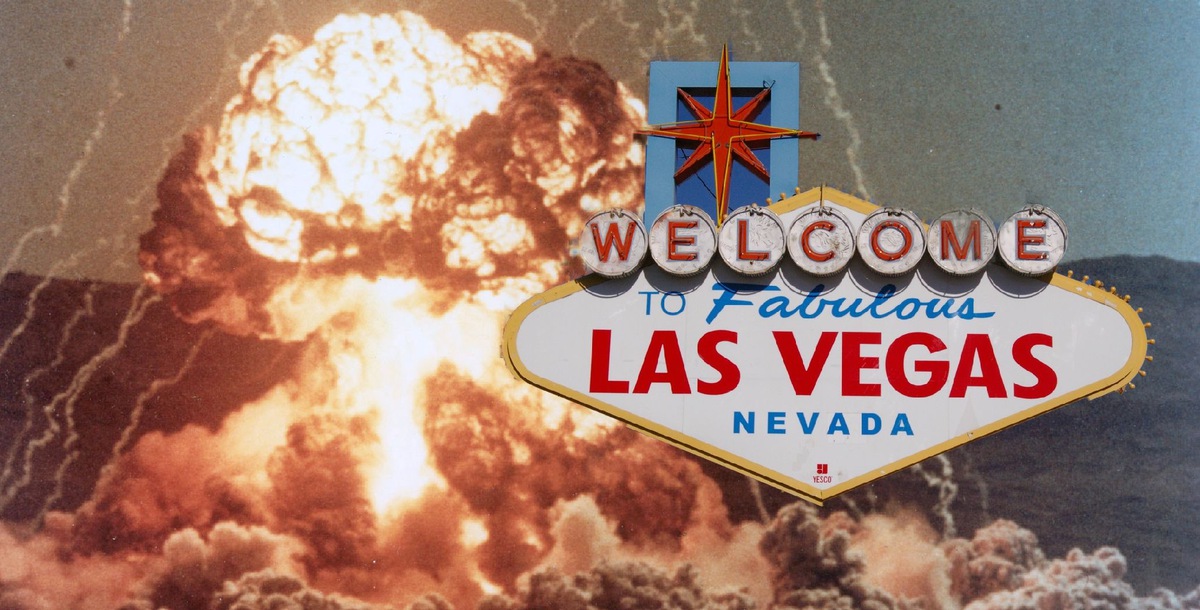
Come for a show, stay for the atomic bombs in Las Vegas! Vegas is a gaming and entertainment mecca famous for its notorious nickname Sin City. People go there to indulge, believing the old maxim that “what happens in Vegas, stays in Vegas.” In other words, just about anything goes in Sin City, and no word travels to the folks back home about that bad behavior, whether you’re a huge star or a soon-to-be-married fellow whose bachelor party is held in a local hotel room. It’s as though Vegas exists in a moral vacuum, so no one worries about what they do while inside that vacuum.
It’s hard to imagine today, but one activity folks used to enjoy in Vegas had nothing to do with slot machines or the blackjack tables and everything to do with atomic bombs. From 1951 and continuing for several years, people watched nuclear tests light up the Vegas skyline, and reveled in the sight of these gargantuan bombs going off, irrespective of the danger they presented.
It’s a mindset that’s hard to fathom today, knowing what we know about the risks inherent in all things nuclear. But back then, local officials saw a business opportunity to exploit the risk and danger, and — true to Vegas’ nature — they seized that opportunity and made it work for the city. What unfolded was the strange scene of nuclear explosions becoming a tourist attraction in Las Vegas during the 50s.
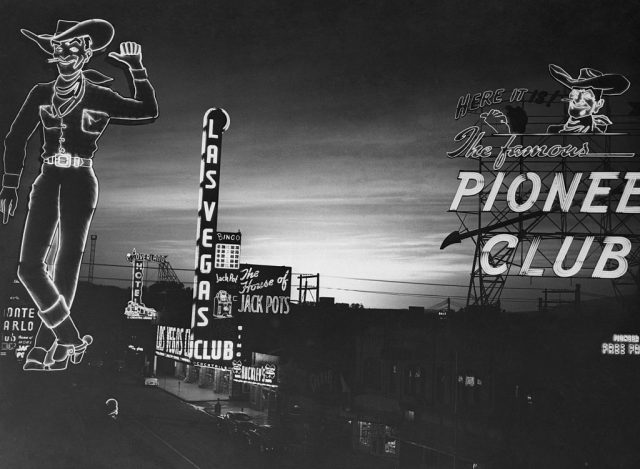
They even held a contest to find “Miss Atomic Bomb,” and chose a Jayne Mansfield-like pinup girl, Lee Merlin, who looked and posed just like the movie star to promote atomic-related events.
One gamer in the city back then said, “the best thing to happen to Vegas was the Atomic bomb,” according to one reporter who was there for the contest. While the rest of the country was living in fear of nuclear Armageddon, Vegas residents and tourists alike were throwing all-night viewing parties, to see the sky lit up by mushroom clouds during tests in the desert.
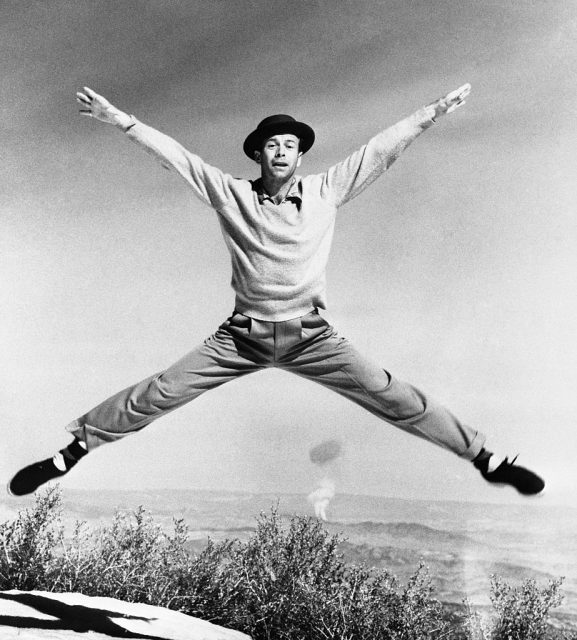
Not everyone was enamored with the tests and the resulting bright lights, however. City officials handed out army-issue dog tags to children, lest their parents be unable to identify them after a failed nuclear test, or the real case scenario. So Vegas was this metaphorically split personality — half partying with abandon close to the tests, and the other experiencing mortal apprehension of potential consequences.
“They would light up the sky,” recalled Allen Palmer, executive director of the National Atomic Testing Museum in 2014. “It (the tests) turned night into day.”
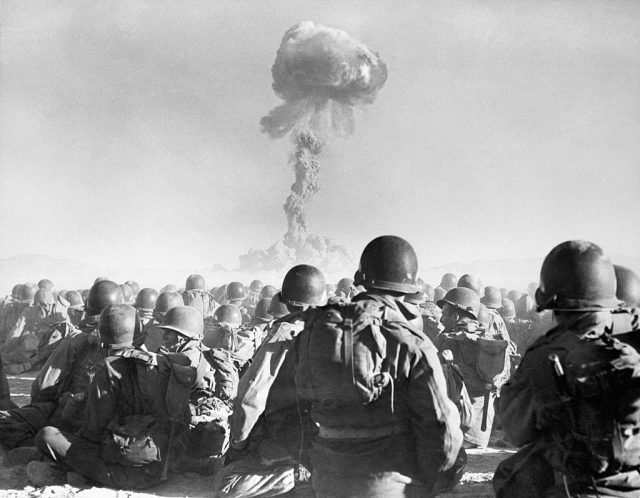
Palmer acknowledged the kind of split personality of Vegas in those days. He said, “People were fascinated by the (mushroom) clouds, by this idea of unlocking the secrets of (the) atom. But there was absolutely an underlying fear — we were so close by.”
By “close by” Palmer means just 65 miles north west of the city, at the Nevada Proving Ground, as it was called. Back then, many tests were held above ground, a reckless move that only by luck, or grace, did not result in catastrophe from radiation fallout or something similar.
https://www.youtube.com/watch?v=DAsVxeYDZgM
In addition to parties and a pinup girls, the city offered calendars publicizing viewing events, casinos and hotels offered “Atomic Cocktails,” and information about “Dawn Bomb Parties.” Such revelry seems incomprehensible now, perhaps, but people were not aware of the potentially devastating after effects of nuclear tests, particularly those done above ground.
That method came to a grinding halt in 1963, immediately after the Cuban Missile Crisis brought America to the very brink of disaster. Tests in plain sight, so to speak, were deemed too provocative and blatant, and cooler heads prevailed. Most tests thereafter were conducted underground, and continued for about four decades.
Related Article: How Bugsy Siegel and the Mob Gave Rise to Modern Las Vegas
But for about 10 years, Las Vegas celebrated the country’s nuclear achievements by partying in the lights created by testing bombs. If it seems counter-intuitive to celebrate something so destructive as atomic bombs, well, that’s Las Vegas for you.
Atomic Tourism
Exploring the worlds atomic and nuclear sites, nevada test site.

Wondering where you can see blast craters from Nuclear Bomb Testing, tour a Nuclear Waste site, learn more about the United States Atomic Bomb program, and lots more all in one day and for free? That’d be the Nevada National Security Site and they run a tour every month, departing from the National Atomic Testing Museum .
Find out more and book a tour by visiting the Nevada National Security Site website.
Note: As we weren’t allowed to take photo’s at the Nevada Test Site all photos in this page are courtesy of National Nuclear Security Administration / Nevada Field Office.
24 comments
When are the tours scheduled for October 2014? I can’t find any info about these tours on the related website. Thank you.
It looks like they’ve changed the link again. I’ve updated our site and just checked for you however the tours are fully booked until 2015. You can find out more on this link .
I’m interested in touring the Test site if possible in January 2015. My friend and I will likely be heading to Las Vegas towards the end of that month. Would you please advise me of the tour schedule for that time period and the procedures that we will need to follow to apply to tour the site? Thank you!
Actually please disregard – your link in the previous person’s response email provided me with the info required. Thanks!
Ok – I do require clarification – I’m a Canadian Citizen and who will be touring the area and have been wanting to tour the site for some time now. Is this possible?
You’ll need to contact the DOE directly, but yes you don’t have to be an american citizen to tour the site. If you visit this link: http://www.nv.energy.gov/outreach/tours.aspx and scroll down to where is says ‘How To Register’ all the details you need are there. Thanks for visiting my site.
I don’t see that the website is valid any longer. Do you have an updated contact or website?
I’ve just updated the link on the page, the current link is now: http://www.nnss.gov/pages/PublicAffairsOutreach/NNSStours.html
I live in Pahrump and would like to drive out to see this crater and learn more. Is it possible to just drive there?
Unfortunately not, your only able to visit as part of a tour.
Are there still tours being offered. The link to the site is not functioning.
Ryan, thanks for letting me know, I’ve fixed the link. The tours are still running and you can book for 2017 here http://www.nnss.gov/pages/PublicAffairsOutreach/NNSSSiteTours.html
Must persons interested in one of the tours go with a group or can they go individually?
Hi Tom, Unfortunately you have to go on a tour, it’s not possible to go individually.
Hi Simon, Wondering – are these tours still running. I can’t seem to find any current info or working links tours at DOE. Cheers
Hi Charlotte, thanks for letting me know, i’ve updated the site with the new link
http://www.nnss.gov/pages/PublicAffairsOutreach/NNSStours.html
I live in Phoenix, and worked at the Portsmouth, Oh. area Gaseous Diffusion Plant in the 1970’s. I had a “Q” Level DOE Security Clearance while working there, that has long since expired. Looks like you are booked for 2017, I’ll look at the 2018 schedule when released. Interested not only in the tour, but anxious to speak with any DOE Officials about my time at the “A-Plant.”
I tried to access the link you provided to Charlotte but I’m unable to clink on the actual “NNSS Site Tours” link. Are they still running?
Thank you! Lindsey
Hi Simon, It seems as though the link has once again changed, or the tours are no longer offered. I can’t seem to find the link anywhere. Any assistance would be greatly appreciated!
I’ve just checked and the link is working currently, though looking at there page it appears all the tours for the rest of the year and first half of 2019 are already full 🙁
https://www.nnss.gov/pages/PublicAffairsOutreach/NNSStours.html
Unfortunately, the link you have provided for the tour, is not working or perhaps, only available for users in the states.
I’ve just checked it and it’s still working ok for me. I’m in the UK myself.
This crater is a perfect spot for a group photo, yet no one is allowed a phone or camera to take said group photo…….
I didn’t find out until I was there but it is possible to arrange for one of their staff to take the photo for you, however it needs to be agreed with them when booking the tour.
Leave a Reply Cancel reply
Your email address will not be published. Required fields are marked *
This site uses Akismet to reduce spam. Learn how your comment data is processed .
Atomic Testing Draws Tourists to Las Vegas
- Sally McCloskey, a ballerina and dancer from the Sands hotel, performed an interpretive dance on top of Mount Charleston called the 'Angel's Dance,' with an atomic mushroom cloud in the background on April 6, 1953. Las Vegas News Bureau photographer Don English thought up this publicity stunt, which proved to be a great success. In addition to the local 'Review-Journal', several other publications across the nation published this photo including 'Parade', a widely-circulated Sunday newspaper magazine. The 'Parade's' caption stated, 'Her task: to interpret the greatest drama of our time in dance rhythms. For high over her sinuous, leaping form rose a symbol no eye could miss: the pale, rising cloud of an atomic bomb just exploded 40 miles away.'
- The atomic mushroom cloud from The Priscilla Test, part of Operation Plumbbob, raised over Fremont Street on June 24, 1957. Las Vegas News Bureau photographer Don English accidentally captured this iconic image when he slept in and had to rush downtown to capture the blast on top of the drugstore. English recalls that he looked up, 'and by gosh all of a sudden there was the mushroom cloud right between Vegas Vic and the Pioneer Club, absolute perfectly in the center.' This famous image was published around the world and won 'LIFE' magazine's 'picture of the week.'
- Photographers captured an atomic blast at News Nob, the designated site for reporters to record images of the atmospheric tests, northwest of Las Vegas, Nevada, on June 24, 1957. In reaction to people’s interest, the Las Vegas Chamber of Commerce promoted the dates and times for these tests. Calendars and community announcements would be published months in advance for tourists to plan and enjoy the spectacle of the mushroom cloud, and the Las Vegas News Bureau would capture the blasts from various perspectives and these images were published around the world.
- On May 24th, 1957, the Las Vegas News Bureau captured the famous 'Miss Atomic Bomb' photo to coincide with Operation Plumbbob at the Nevada Test Site. News Bureau photographer, Don English, took the famous photo of the showgirl from the Sands’ Copa Room, thought to be Lee Merlin. The publicity photo is the most published photo in the Las Vegas News Bureau collection and has appeared and continues to appear in hundreds of publications worldwide.
- Photographers gathered outside of the Nevada Test Site at News Nob (which was only ten miles from ground zero), to shoot the atomic blast from the ESS Test, part of Operation Teapot, which was sponsored by the Los Alamos National Laboratory on March 23, 1955.
- Zsa Zsa Gabor and Spaulding Bisbee, The Civilian Defense Director of Maine, were at a meeting of the Ancient and Honorable Society of the Atom Bomb Watchers at the Flamingo, circa 1953.
- Actress Marie Wilson posed poolside at the Flamingo with a Geiger counter to promote atomic tourism in Las Vegas on February 10, 1955. There were two atmospheric tests in February 1955, named Wasp and Moth, which were part of Operation Teapot.
- Employees outside of the Civil Defense Administration in Las Vegas inspected mannequins from J.C. Penney which were sent to Yucca Flat on April 4, 1958. The mannequins were positioned around a million-dollar village, which was built to test the effects of an atomic blast on everything from food to clothing to homes made from different materials.
- Actor and comedian Danny Thomas posed outside of the Nevada Test Site on May 20, 1957, for a staged photo that would be placed in the Sands casino's time capsule to preserve the memory of nuclear testing outside of Las Vegas.
- NATO military observers watched Boltzmann, an above ground atomic test, which was part of Operation Plumbbob at the Nevada Test Site outside of Las Vegas on May 28, 1957.
- Eugene Gaynes, an atomic radiation victim, was examined outside of the United States Atomic Energy Commission's office in Las Vegas, circa 1954.
- Atomic soldiers arrived at the Royal Nevada on April 18, 1955. The soldiers were in Las Vegas for Operation Teapot, which was part of the atmospheric tests at the Nevada Test Site, northwest of Las Vegas.
- A mushroom cloud from the Hood Test, which was part of Operation Plumbbob at the Nevada Test Site on July 5, 1957. The test, sponsored by Lawrence Livermore National Laboratories, was the largest test ever conducted at the site with a yield of 74 kilotons.
- President John F. Kennedy toured the Nevada Test Site northwest of Las Vegas on December 8, 1962. While there, President Kennedy took an hour-long helicopter flight over the test site to see the damage an atomic blast could create. He also visited Area 25, which had been set aside for atomic research that did not involve weapons testing.
- Guests at the Last Frontier pool watched as a mushroom cloud rose from the Simon Test, part of the Operation Upshot-Knothole, at the Nevada Test Site outside of Las Vegas on April 25, 1953. The Las Vegas Chamber of Commerce issued a calendar for tourists, listing the scheduled times of the bomb detonations and the best places to view them.
- American opera singer Marquerite Piazza posed as 'Miss Radiation' with servicemen at the Sands' pool on March 29, 1955, to promote atomic tourism in Las Vegas.
- An atomic blast over Fremont Street, circa 1955. Las Vegas utilized its close proximity to the atomic testing grounds to promote itself as, 'Atomic City' a place where people could go and view atomic blasts. According to PBS An American Experience, 'On the eve of detonations, many Las Vegas businesses held 'Dawn Bomb Parties.' Beginning at midnight, guests would drink and sing until the flash of the bomb lit up the night sky.'
- An atomic mushroom cloud rose over the El Rancho Vegas on April 18, 1953. The blast, named Badger, was part of the Operation Upshot-Knothole, at the Nevada Test Site outside of Las Vegas. It was the sixth test in the series of atmospheric nuclear weapons testing.
- Priscilla, an atomic blast that was part of Operation Plumbbob, rose above Fremont Street on June 24, 1957. The test was performed at the Nevada Test Site 65 miles northwest of Las Vegas.
- According to the Smithsonian Channel, 'During the 1950s, the detonation of the Nevada Test Site gave Las Vegas a new way to make money, atomic tourism.' Proof of this mushrooming tourist industry can be seen here as tourists view an atomic blast from Fremont Street, circa 1955.
Looking for higher-quality images? Fill out a formal image request .
- Privacy Policy & Terms of Use
- VisitLasVegas.com
- VisitLaughlin.com
- VisitMesquite.com
- VisitBoulderCity.com
- VegasMeansBusiness.com

Back to top
Support the Atomic Museum!
Be the Person Behind Our Success!

The Role of Vegas in Nuclear Research History Explained
by Info AtomicMuseum | Aug 13, 2024 | Attractions , Las Vegas | 0 comments
Amid the glittering lights and the ceaseless clamor of slot machines, Las Vegas harbors a lesser-known legacy as a pivotal site in the saga of Vegas nuclear research. Less than a hundred miles from the neon glow, the Nevada National Security Site, formerly the Nevada Testing Site, was the backdrop for some of the most groundbreaking events in the annals of nuclear history.
How did this bustling tourist hub become a cornerstone of nuclear research? The unfolding story reveals a complex tapestry of scientific breakthroughs and geopolitical maneuvers that helped shape the modern world.
This article peels back the layers of Las Vegas’s atomic past to explore its crucial role in global nuclear research and the indelible marks it has left on science, politics, and culture.
The Establishment of the Nevada National Security Site
In December 1950, against the backdrop of escalating tensions between the United States and the Soviet Union, President Harry S. Truman authorized the creation of the Nevada National Security Site (NNSS) . This decision marked a pivotal moment in Vegas nuclear history by positioning the area as a central player in the nation’s nuclear weapons testing program.
The choice of location was strategic. A remote desert environment, approximately 65 miles northwest of Las Vegas, provided the isolation needed for such sensitive and dangerous experiments.
The vast, uninhabited space offered a natural barrier. It reduced the risk to populated areas while enabling large-scale detonations that were essential for advancing nuclear technology.
The first test conducted at the NNSS was “Able,” a 1-kiloton bomb detonated on January 27, 1951 . This test was significant not only as the site’s inaugural explosion but also as the beginning of a series of tests that would shape the future of nuclear weaponry.
Over the next four decades, the NNSS would host over 1,000 nuclear tests, both above and below ground. These tests provided critical data that fueled the United States’ arms race with the Soviet Union.
The Cold War Era and Nuclear Advancements
During the Cold War, the Nevada National Security Site became a proving ground for some of the most significant nuclear research breakthroughs of the 20th century. The tests conducted here were not merely demonstrations of power. They were intricate scientific experiments designed to push the boundaries of what nuclear weapons could achieve.
This period saw the development of a range of nuclear devices, from smaller tactical weapons to massive hydrogen bombs capable of unprecedented destruction. The data gathered from these tests was invaluable. It informed both military strategies and scientific understanding of nuclear physics. For instance, the transition from atmospheric to underground testing in the early 1960s was a direct response to concerns about radioactive fallout, which led to the development of more advanced containment and detection technologies.
These advancements not only enhanced the effectiveness of nuclear weapons but also shaped international treaties and agreements, such as the Partial Test Ban Treaty of 1963, which prohibited all nuclear explosions except those conducted underground .
The impact of the Nevada National Security Site on global nuclear policy cannot be overstated. The information gleaned from these tests allowed the United States to maintain a strategic advantage over its adversaries and reinforced its position as a dominant nuclear power.
Cultural Impact on Las Vegas
The proximity of the Nevada National Security Site to Las Vegas had a profound impact on the city, transforming it into an unlikely observer and participant in the atomic age. During the 1950s and 1960s, the sight of mushroom clouds rising from the desert became a surreal yet commonplace experience for residents and tourists alike.
This phenomenon gave rise to what is now known as “atomic tourism,” where visitors would flock to Vegas hotels and rooftops to witness the tests firsthand.
Vegas nuclear history is marked by this unique blend of entertainment and atomic spectacle . The city embraced its connection to the nuclear age, with businesses capitalizing on the public’s fascination with atomic energy. Hotels offered “dawn parties” timed to coincide with scheduled detonations, and atomic-themed merchandise and cocktails became part of the local culture.
The economic impact of nuclear testing extended beyond tourism. The influx of government workers, scientists, and military personnel to the area contributed to the rapid growth of Las Vegas, transforming it from a small desert town into a thriving metropolis.
Ongoing Vegan Nuclear Research and Legacy
The legacy of the Nevada National Security Site continues to resonate today, both in the scientific community and among the general public. Initiatives like the Nevada National Security Site Oral History Project, conducted by the University of Nevada, Las Vegas (UNLV), play a crucial role in preserving the stories and experiences of those who were directly involved in the nuclear testing program. This project collects testimonies from a diverse range of individuals, including:
- Military personnel
- Local residents
The environmental and social impacts of desert nuclear testing are subjects of ongoing research and debate. The tests conducted at the NNSS left a lasting mark on the landscape, with some areas remaining off-limits due to residual radiation.
The long-term health effects on workers and nearby communities are also a critical area of study, with researchers examining the correlation between exposure to radiation and increased rates of cancer and other illnesses.
Despite the cessation of active testing, the Nevada National Security Site remains a focal point for discussions on nuclear policy and environmental stewardship. The data collected during the testing years continues to inform current nuclear research, particularly in areas related to non-proliferation and disarmament.
The ongoing relevance of the NNSS underscores the importance of preserving its history , not only as a reminder of the past but as a resource for shaping the future of nuclear science and policy.
Explore Nuclear Legacies in Las Vegas
As we reflect on the monumental role of Vegas nuclear research in shaping both scientific discovery and international policy, it becomes clear that the echoes of these groundbreaking tests are not just historical footnotes but are actively preserved and interpreted today at The Atomic Museum. Here, visitors can engage with exhibits that span 70 years of nuclear history, including rare artifacts like a large nuclear reactor and the Genie missile.
What sets The Atomic Museum apart is its commitment to educating through authentic artifacts and compelling narratives. Plan your visit today to experience firsthand how Las Vegas influenced global nuclear research and policy.
Submit a Comment Cancel reply
Your email address will not be published. Required fields are marked *
Save my name, email, and website in this browser for the next time I comment.
Submit Comment
Related Articles


8 Fun Las Vegas Summer Activities for Everyone
by Info AtomicMuseum | Jul 15, 2024
Want the best summer experience in Las Vegas? Discover amazing activities and have a summer to remember. Get started on your adventure!

6 Mind-Blowing Fun Facts About Nuclear Energy
by Info AtomicMuseum | Jun 13, 2024
Uncover fun facts about nuclear energy & learn how this powerful source impacts us. Dive into fascinating details at Atomic Museum Vegas!

The Atomic Museum’s Smithsonian Affiliation
by Info AtomicMuseum | May 21, 2024
Discover the perks of The Atomic Museum’s Smithsonian Affiliation. Gain access to 57 museums nationwide, uncover nuclear history, and more.
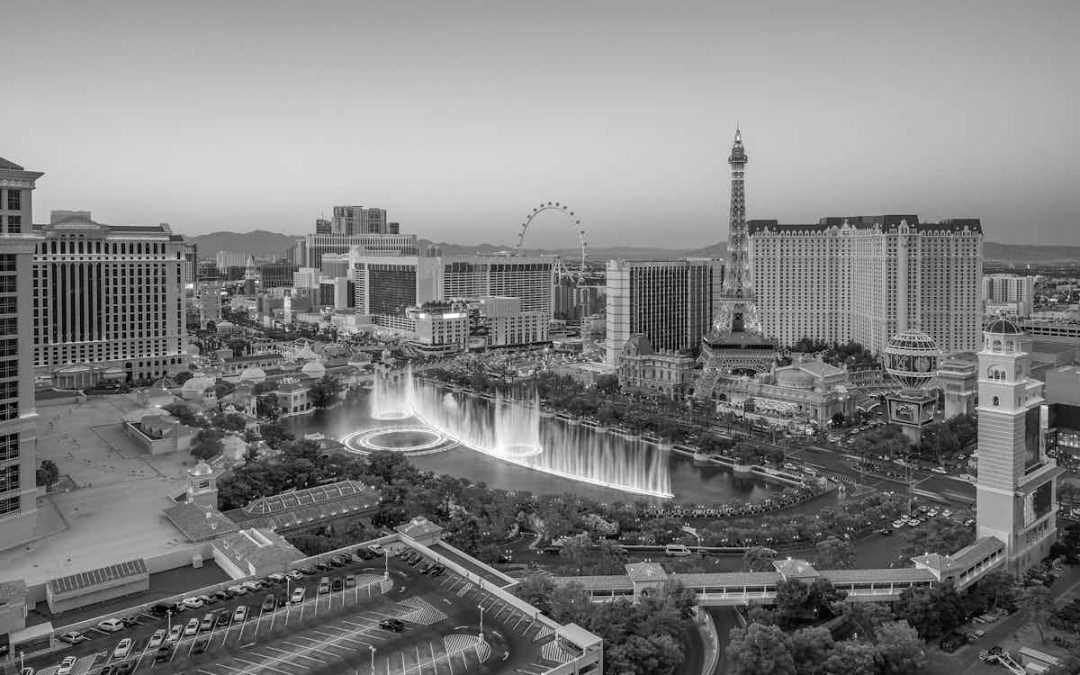
The Atomic Museum’s Role in Preserving Our Nuclear History
by Info AtomicMuseum | May 17, 2024
Learn about humanity’s atomic legacy at the Atomic Museum. Delve into nuclear history, from the Manhattan Project to modern nuclear testing.
Join Us at the Atomic Museum!
Experience Nevada’s explosive History! The Atomic Museum is one of a handful of private national museums and showcases some of the rarest of artifacts relating to the nation’s atomic testing program. Nowhere else can you see a large nuclear reactor that was used in the development of the nuclear rocket and the first air-to-air missile, Genie. Personal atomic weapons that were developed to use in place of conventional weapons such as the Backpack Nuke and the Davy Crockett Weapon System (recoilless gun) are placed throughout the 8,000 square feet of museum exhibits.
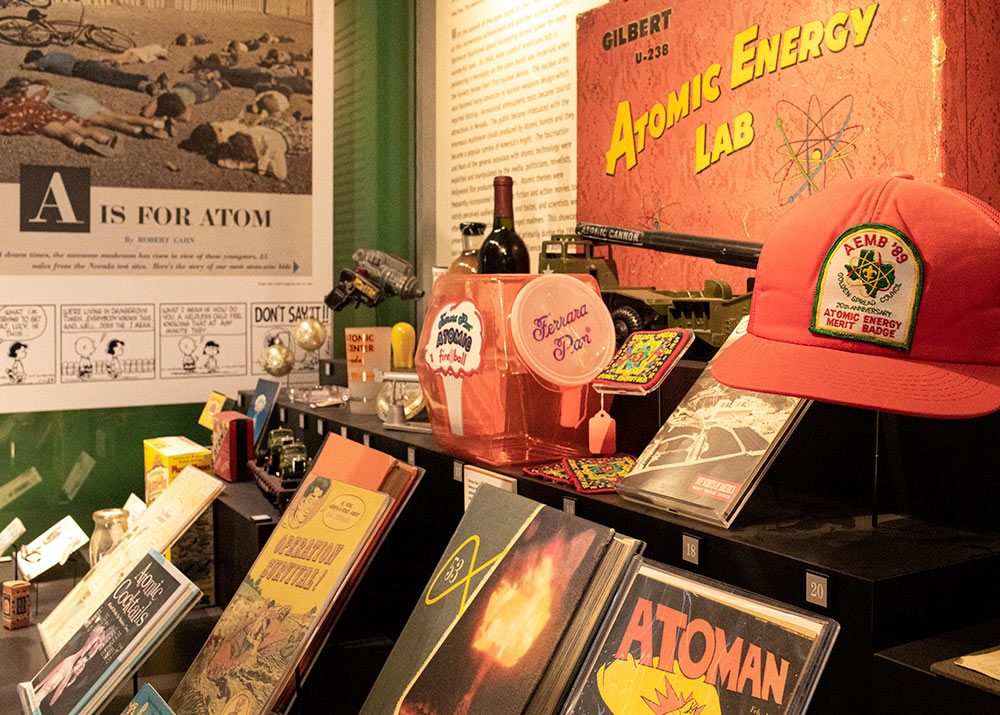

- Entertainment
- Investigations
- Latest Headlines
- Robert Telles Trial
- Top 100 Restaurants
- Things To Do In Vegas
- What Are They Hiding?
- Election 2024
- Israel at War
- 2024 Election
- Clark County
- Nation and World
- Science and Technology
- Road Warrior
- Las Vegas Weather
- East Valley
- North Las Vegas
- Summerlin/Centennial Hills
- Remembering Oct. 1, 2017
- Deborah Wall
- Natalie Burt
- Remembering Jeff German
- Police Accountability
- Alpine Fire
- 100 Years of Growth
- Dangerous Driving
- Raiders News
- Golden Knights
- UNLV Football
- UNLV Basketball
- Nevada Preps
- Sports Betting 101
- Las Vegas Sportsbooks
- On TV/Radio
- MMA and UFC
- Casinos & Gaming
- Entrepreneurs
- Real Estate News
- Business Press
- Sheldon Adelson (1933-2021)
- Debra J. Saunders
- Michael Ramirez cartoons
- Victor Joecks
- Richard A. Epstein
- Victor Davis Hanson
- Drawing Board
- Homicide Tracker
- Faces of Death Row
- Kats’ Cool Hangs
- Arts & Culture
- Home and Garden
- Las Vegas Hiking Guide
- RJ Magazine
- Today’s Obituaries
- Submit an obit
- Dealer News
- Classifieds
- Place a Classified Ad
- Provided Content
- Real Estate Millions
- Internships
- Service Directory
- Transportation
- Merchandise
- Legal Information
- Real Estate Classifieds
- Garage Sales
- Contests and Promotions
- Best of Las Vegas
- Nevada State Bank
- Verizon Business
- Touro University
- P3 Health Partners
- Find My Forever
- Ignite Funding
- Travel Nevada
- Subscriptions
- Newsletters
- Advertise with Us
- >> News
- >> Politics and Government
- >> Nevada
Project 2025: Nevada’s 5 takeaways from controversial plan
Project 2025 is a 900-page blueprint of policy proposals written by authors close to Donald Trump that a Republican presidential candidate could implement in 2025. Here’s how it could affect Nevada.

A conservative set of policy proposals has become one of Democrats’ main criticisms of a potential second Trump presidency, and although the former president has tried to distance himself from the controversial project, it continues to weigh down his campaign.
Regardless of how much or how little of the project might get implemented under a second Trump term, it has a few elements that pertain specifically to Nevada.
Project 2025, also known as the “2025 Presidential Transition Project,” is a 900-page blueprint of policy proposals written by authors close to former President Donald Trump and launched by the Heritage Foundation that a Republican presidential candidate could implement in 2025.
Among many other ideas, the project proposes replacing career government officials with political appointees, eliminating the Department of Education, restricting contraception and reversing policies that allow transgender people to serve in the military.
Vice President Kamala Harris and her supporters warned Trump would implement aspects of Project 2025 during her rally in Las Vegas , echoing an increasingly common Democratic attack against Republicans.
Trump has said on his social media platform that he knows “nothing about Project 2025” and has “no idea who is behind it.” His campaign has instead focused on the 16-page GOP platform that highlights energy independence, securing the southern border, implementing tax cuts and the “no tax on tips” plan, and securing elections through voter ID and paper ballots.
Here’s what Project 2025 has to say about Nevada.
1. It calls to “restore readiness” of nuclear testing.
In its section about defense, one of the authors of Project 2025, Christopher Miller, wrote the U.S. must restore its nuclear infrastructure so that it is “capable of producing and maintaining nuclear weapons.”
It specifically proposes restoring readiness to test nuclear weapons at the Nevada National Security Site, located about 65 miles northwest from Las Vegas, to ensure the U.S. can respond quickly to “asymmetric technology surprises.”
Nevada has not conducted an explosive nuclear test since 1992, when President George H.W. Bush signed legislation imposing a moratorium on nuclear testing. Since then, the security site’s primary mission has been to support nuclear nonproliferation, or preventing an increase in nuclear weapons.
Project 2025 also says in its energy chapter that the U.S. and the NNSA “needs to make the design, development, and deployment of new nuclear warheads a top priority.” It says the U.S. lacks sufficient plutonium production capabilities.
It also calls for rejecting the ratification of the Comprehensive Test Ban Treaty and instead “indicate a willingness to conduct nuclear tests in response to adversary nuclear developments if necessary.”
2. It calls for taking another look at Yucca Mountain.
In 2002, the Department of Energy recommended Yucca Mountain, 90 miles northwest of Las Vegas, as a federal nuclear waste repository. Efforts to move forward on the project have come up over the years, but each time they came to a screeching halt, largely due to the resounding bipartisan opposition from Nevada’s federal officials .
Project 2025, however, calls for it to be looked at again and for its licensing process to be restarted.
“Providing a plan for the proper disposal of civilian nuclear waste is essential to the promotion of nuclear power in the United States,” the Project 2025 chapter written by Bernard L. McNamee, says.
The project calls for the next presidential administration to work with the Nuclear Regulatory Commission to review the Department of Energy’s permit application for Yucca Mountain.
“Yucca Mountain remains a viable option for waste management, and DOE should recommit to working with the Nuclear Regulatory Commission as it reviews DOE’s permit application for a repository,” it reads.
McNamee stressed, however, that finishing the review of the project does not mean Yucca Mountain would be completed and operational but “merely presents all information for the State of Nevada, Congress, the nuclear industry, and the Administration to use as the basis for informed decisions.”
3. It proposes a humane disposal of Nevada’s wild horses and burros.
The country’s wild horses and burros — about 60 percent of which live on public land in Nevada — are an icon of the American West but for years have been struggling with overpopulation. To control the population, the Bureau of Land Management has instituted multiple programs, from sterilization to adoptions.
Project 2025 author William Perry Pendley wrote in the Department of the Interior Chapter that those programs are not enough to solve the problem. He called on Congress to enact laws permitting the Bureau of Land Management to “dispose humanely” of some wild horses and burros to curb overpopulation.
BLM allows for the euthanasia of a wild horse or burro if it is sick and has a poor prognosis for recovery, according to the Bureau of Land Management’s guidance for euthanasia.
4. It could adjust Nevada’s national monument territories.
Project 2025 says the new presidential administration should review national monument designations to see if they were improperly designated. It will “permit a fresh look at past monument decrees and new ones by President Biden.”
That could include Avi Kwa Ame.
It would also like to see the size of national monuments to be reduced, and it calls to repeal the Antiquities Act of 1906, which allowed Biden to designate Avi Kwa Ame as a national monument.
5. Nevada’s water storage could be updated.
Project 2025 also includes provisions relating to western water storage. It calls for developing additional water storage capacity in the west by updating dam water control manuals for facilities, reducing bureaucratic inefficiencies by consolidating federal water working groups, adopting improvements related to forecast informed reservoir operations and aerial snow observation systems.
It also calls for clarifying the Water Infrastructure Finance and Innovation Act in order to foster more opportunities for locally led investment in water infrastructure.
During his first presidency, Trump issued a memorandum aiming to streamline water infrastructure processes and improve use of technology to increase water reliability. Project 2025 calls for reinstating that memorandum.
Contact Jessica Hill at [email protected]. Follow @jess_hillyeah on X.


A poll among registered Latino voters in Nevada determined that Vice President Harris had an edge of 18 percentage points over former President Donald Trump.

Two elevators will be added and 38 others will be modernized under a Biden administration infrastructure grant program, with work beginning next month.

Sen. Catherine Cortez Masto said she is “more than happy” with her role as senator, in response to a report her name was among those suggested for a top cabinet position.

The decision on water cuts is based on projections for Lake Mead and Lake Powell for the next two years. Here’s what Southern Nevadans should know.

The seasonally adjusted unemployment rate in Nevada rose 0.2 percentage points to 5.4 percent, according to a Department of Employment, Training and Rehabilitation report.

Wednesday marked the 89th anniversary of the establishment of Social Security. Democrats claim Republican opponents are threat to the program.

The Imperial Irrigation District will receive millions in Inflation Reduction Act funds to pay farmers in exchange for not using water from the Colorado River.

Here are the main takeaways about Las Vegas and the Colorado River’s future from U.S. Rep. Susie Lee’s second-ever water summit.

The American Civil Liberties Union has filed a complaint against the Nevada State Board of Massage Therapy.

Transportation Secretary Pete Buttigieg said July’s Interstate 15 traffic chaos, caused by a truck crash, underscores the importance of adding alternative modes of travel.

Alert spurred by transformer fire at Plant Vogtle, a nuclear power plant in Georgia, ends

WAYNESBORO, Ga. ( WRDW/WAGT /Gray News) - A transformer fire triggered an “alert” Tuesday at Plant Vogtle in Georgia.
According to officials with Burke County, the alert ended at 2:36 p.m. Georgia Power said the fire was outside the nuclear portion of the plant and was extinguished quickly.
Fires at nuclear power plants can be serious – not so much because of the reactor but because fires can cause a loss of power – and without power, the reactor’s cooling systems could fail.
The alert was first declared at around noon Tuesday, according to the company.
Officials said no one was hurt and the plant was at full power.
Among the four categories of emergencies designated by the Nuclear Regulatory Commission, an alert is the second least serious.
The incident happened at Units 1 and 2, the older part of the plant, according to the company.
From outside the plant grounds Tuesday afternoon, steam was coming from all four cooling towers.
An alert “means an event has occurred that could reduce the plant’s level of safety,” the company said in a statement.
“There should be no danger to the public. County and state officials will be involved and prepared for any necessary response. You will not need to take any actions unless directed to by state and local officials,” the company said.
The U.S. Nuclear Regulatory Commission as well as state and local agencies were notified of the declaration.
“Our top priority is the safety and health of the public and our employees,” said Units 1 and 2 Site Vice President John Weissinger. “We will provide more details as soon as they are available, and we will continue to do so until this situation is safely resolved.”
The statement continued: “The company is committed to the safe operation of our nuclear-generating facility with equipment and systems that meet strict NRC safety and design regulations. Our highly trained plant operators are investigating this situation and initiating a plan for resolution.”
The Burke County Emergency Management Agency also reported the alert.
“We have been notified of an ALERT level emergency declared at Plant Vogtle,” the agency posted on Facebook around 1 p.m. Tuesday. “An Alert level emergency means: an event has occurred that could reduce the plant’s level of safety. There should be no danger to the public.”
The agency added: “NO PROTECTIVE ACTIONS ARE NEEDED AT THIS TIME. Please stay tuned for any future updates.”
It’s only been weeks since the newest unit opened at the plant – seven years late and well over budget.
Units 1 and 2 have been operating at the plant for decades, while Units 3 and 4 have been under construction in recent years.
Unit 3 began operation about a year ago and then Unit 4 went online in April. They’re the first new nuclear reactors in the U.S. in over 30 years.
The expansion project’s overall cost, including financing, was listed in December as $31 billion for Georgia Power and three other owners. Add in $3.7 billion that original contractor Westinghouse paid to walk away from construction, and the total nears $35 billion.
Georgia Power owns 45.7% of the reactors. Smaller shares are owned by Oglethorpe Power Corp., which provides electricity to member-owned cooperatives, the Municipal Electric Authority of Georgia and the city of Dalton. Some Florida and Alabama utilities have also contracted to buy Vogtle’s power.
Copyright 2024 WRDW/Gray Local Media, Inc. All rights reserved.

Woman taken off life support after boyfriend allegedly drove off with her on his car trunk

Las Vegas police investigating stabbing near Fremont Street Experience

20-year-old killed by brake caliper that flew through car windshield, family says

Trapeze built in Vegas backyard coming down after complaints from neighbors
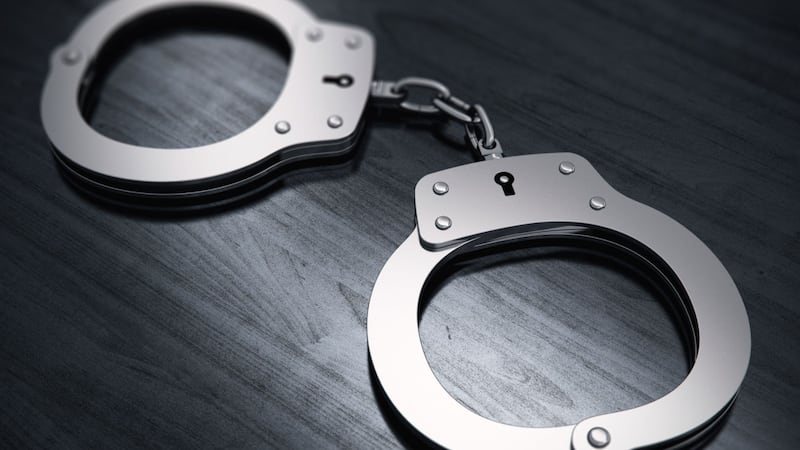
Las Vegas police officer accused of felony child abuse

Family of missing man confirms discovery of body at Lake Mead

LVMPD: Suspected drunk driver crashes into power pole, causes outage on MLK, Lake Mead

4th grader declared brain dead after collapsing at recess on first day of school, family says
Latest news.

Panda twins are born to Ying Ying, the world’s oldest first-time mom

Giant panda gives birth to twins

Looking to buy a home? You may now need to factor in the cost of your agent’s commission

Real estate commission changes take effect

Hurricane Ernesto makes landfall on Bermuda as a category 1 storm

Ernesto slams Bermuda, brings big waves to East Coast

15-year-old student dead following medical emergency just days after start of school year

3 family members killed in crash while on the way to teenager’s college move-in day

- Working + The Economy
- Sustainability
- Politics + Government
- Election 2024
Still overdependent on tourism after all these years

Anirudh Polagani
August 14, 2024 3:55 am.

(Photo: Ronda Churchill/Nevada Current)
Tourism and gaming are the largest economic powerhouses in Las Vegas, bringing in the most money for the regional economy. According to data from the American Gaming Association , the casinos industry’s economic impact in Nevada in 2023 totaled $59.4 billion, and the industry was responsible for supporting more than 330,000 jobs. These figures highlight how important tourism is to the Las Vegas economy. Even though this sounds good in hindsight, the overdependence on tourism creates a challenge for the overall health of the Southern Nevada economy when gaming revenues falter.
Imagine going “all in” in poker, a very risky situation right? Well, that’s the state of Las Vegas’s economy as it is going “all in” on tourism and gaming, making the region very vulnerable to economic shocks. For example, Tourism Analytics (2021) reports during the pandemic, tourism dropped 55% in visitor volume, leading to employment rates in tourism sectors dropping over 32.5%. During just a 78-day casino closure Las Vegas lost over $6.2 billion . Furthermore, the Las Vegas Global Economic Alliance (LVGEA) released “ Vision 2025: A Comprehensive Economic Development Strategy ” highlighting the most important goal for Southern Nevada is to promote a resilient and diverse economy. Moreover, a Southern Nevada regional study prepared by the Brookings Mountain West, the UNLV Center for Business and Economic Research, and the UNLV Transportation Research Center corroborates that Southern Nevada lacks a governance structure to coordinate needed economic and infrastructure priorities. The report notes Southern Nevada’s application for the U.S. Economic Development Administration’s (EDA) Build Back Better Regional Challenge grant offering millions of dollars in funding to support regional economic development initiatives. Even though the grant did not succeed, it still marks an effort to “get in the game” for federal funds to help regional economies.
Even post-pandemic, Las Vegas is finding itself increasingly reliant on the tourism sector. According to the Las Vegas Sun (2024), the Increasing Our Nation’s Value Through Economic Support and Tourism (INVEST) Act, will generate an enormous amount of money for tourism. Nevada Business (2023) reports that the Destination Development Demonstration (3D) grant seeks to bring funds to Nevada’s rural towns to help the long-term development of tourism in the area. Even though such funding creates a positive short-term impact it reflects our dependency on the tourism and gaming sector. The Las Vegas’s tourism and gaming industry continues to create record breaking revenues and we should never fail to make the necessary infrastructure investments in the tourism and gaming sector. We can do two things at once – continue to strengthen our core industry while simultaneously diversifying our economy in sectors where it is needed.
A recent example of this is the success of sports/entertainment investments. For example, the Center for Business and Economic Research at UNLV (2023) quantifies that sporting events in Las Vegas generated $1.845 billion in direct output only in the fiscal year 2022. This is why Las Vegas has been investing heavily in sports such as the teams in the National Football League, the National Hockey League, the Women’s National Basketball Association, and the United Soccer League – all added just in the last decade.
In order to further bolster its economic resilience Las Vegas should implement successful strategies employed by peer cities such as Portland and San Antonio. For example, Portland’s distribution and diverse manufacturing economy is the economic center for Portland. Although Portland’s center of economy is distribution and manufacturing, the city has not failed to diversify its economy. For instance, Portland’s city council approved the enactment of the Climate Investment Plan (CIP) which will invest over $750 million in promoting climate justice and help Portland reach its five-year target of net-zero carbon emissions. According to the Portland Economic Development Strategy , Portland has created a goal to produce 10,000 jobs in five years through investments in green technology and sustainable practices further exemplifying a successful diversification strategy.
Another example is San Antonio, as the core of the economy is the manufacturing industry. However, this city also works to diversify its economy as San Antonio’s direction into the biomedical sector, and partnerships with educational institutions, have stimulated economic growth and innovation. According to the UT Health San Antonio (2020), the healthcare and biosciences industry generated over $42.4 billion and created over 50,000 jobs in 2019, continuing to diversify the local economy.
To increase economic diversification, Las Vegas should establish a governance structure like a council of governments to create and coordinate economic and infrastructure priorities as proposed by the Southern Nevada regional study . This would help develop policies that fosters innovation and sustainable growth across multiple sectors. This initiative could implement a promising environment for tech startups by offering tax breaks, grants, and access to venture capital, similar to the strategies that advanced Portland’s technology and sustainable practices.
Additionally, Las Vegas can utilize its abundant sunshine and continue to become a leader in solar energy by promoting solar panel installations and investing in more solar farms, which will not only create jobs but also reduce the city’s carbon footprint. Even more than this, Las Vegas should partner with local universities and colleges to develop programs focused on industries such as biotech, and renewable energy to also increase the diversification of sectors similar to the approach that San Antonio is taking.
When looking toward the future of Las Vegas, it becomes clear that economic diversification is key to creating a sustainable future. This city can use diversification strategies shown by Portland’s investments in clean energy which is creating jobs and fostering a sustainable environment while having manufacturing and distribution as the center of the economy. Las Vegas can also implement additional diversification strategies shown by San Antonio’s investments in the healthcare and biosciences industry while having the manufacturing industry as the core of the economy. By doing so, Las Vegas can have a resilient and prosperous future, ensuring it stays a vibrant city capable of withstanding economic fluctuations. This is a call to action for Las Vegas to diversify, innovate, and invest in building a robust and diverse economy that extends beyond the glittering lights of the Strip.
Our stories may be republished online or in print under Creative Commons license CC BY-NC-ND 4.0. We ask that you edit only for style or to shorten, provide proper attribution and link to our website. AP and Getty images may not be republished. Please see our republishing guidelines for use of any other photos and graphics.
Anirudh Polagani is a student researcher with Brookings Mountain West and The Lincy Institute at UNLV.
Related News

We've detected unusual activity from your computer network
To continue, please click the box below to let us know you're not a robot.
Why did this happen?
Please make sure your browser supports JavaScript and cookies and that you are not blocking them from loading. For more information you can review our Terms of Service and Cookie Policy .
For inquiries related to this message please contact our support team and provide the reference ID below.

IMAGES
COMMENTS
Nuclear Tourism: When atomic tests were a tourist attraction in Las Vegas, 1950s Las Vegas is known as the city of lights and, at one time, that light was the glow of an atomic detonation in the Nevada desert. Starting in 1951, the US Army began testing nuclear ordnances just 65 miles from Sin City.
Atomic Tourism in Nevada. Photographers and reporters observe atomic explosion in the distance. Courtesy: Las Vegas News Bureau. On April 22, 1952 about 200 reporters from across the country ...
When it comes to understanding the complex and fascinating history of nuclear testing in the United States, there are two places that stand out: the Nevada Test Site and the Atomic Museum. A visit to both of these sites promises an immersive experience that delves into the legacy of nuclear testing, its environmental impact, and the evolution of national security. In this blog post, we'll ...
Are you looking for fun activities in Vegas? Visit the Atomic Museum. Learn about the history of nuclear research. Buy your tickets today.
But in fact, tourists who went to Las Vegas to watch the nuclear tests helped fuel the growth of that city in the 1950s. In the 1950s, the United States carried out over 150 nuclear weapons tests above ground. Some of these tests - particularly the large-scale thermo-nuclear bomb tests like the 1954 Castle Bravo test, which had a 15-megaton ...
Atomic Tests Were a Tourist Draw in 1950s Las Vegas Nevada's nuclear-bomb testing spawned a spectator culture tinged with both profound fear and Sin City delight.
Offering a robust look at the history of nuclear testing in southern Nevada and nationwide get to know Nuclear Nevada history at the National Atomic Testing Museum in Las Vegas. Learn more from Travel Nevada.
Between 1950 and 1960, the population of Las Vegas grew by 161%--partly due to the burgeoning casino industry. But another reason was a chance to glimpse actual nuclear tests in person.
Atomic Tourism In Las Vegas. During the Cold War of the 1950s and early 60s, Nevadans timed their days to watch the U.S. government's nuclear explosions as they tested atomic weapons at the nearby ...
The Atomic Museum is a national science, history, and educational institution that tells the story of America's nuclear weapons testing program at the Nevada Test Site.
Between 1950 and 1960 the population grew by 161%, partly due to the burgeoning casino industry, but another reason was the chance to see live nuclear tests in person. During these years, Las Vegas capitalized on "atomic tourism," and hotel guests witnessed nuclear testing directly from their hotel windows.
Learn how you can visit and tour the Nevada Test Site, now known as the Nevada National Security Site where atomic testing was conducted.
Footage of atomic tests conducted in Nevada in 1955. Back in the 1950s, Las Vegas was not quite the same glitzy tourism magnet that it is today. In fact, part of the reason that Nevada was chosen for the nuclear test site was because, at the time, Las Vegas' population was small enough (under 40,000).
Tours are operated on a chartered bus with a restroom. Visitors depart from the Atomic Museum and travel 65 miles northwest of Las Vegas, where you will cover nearly 250 miles of the Site. Each tour accommodates 50 people.
e world have visited the vast outdoor laboratory. Public, civic and technical tours of the Site are provided by the U.S. Department of Energy, National Nu. lear Security Administration Nevada Field Office. Spanning 1,355 square miles, the Site is larger than the state of Rhode Island, and features artifacts and archaeological sites from the ...
Las Vegas has its fair share of amazing attractions, but sometimes it's fun to step away from the casinos to explore a little piece of history. The Las Vegas Nuclear Test Museum explores the history of nuclear testing and highlights the intriguing story of the Cold War and America's nuclear program. Whether you're a history enthusiast ...
Atomic tourism or nuclear tourism is a form of tourism in which visitors witness nuclear tests or learn about the Atomic Age by traveling to significant sites in atomic history such as nuclear test reactors, museums with nuclear weapon artifacts, delivery vehicles, sites where atomic weapons were detonated, and nuclear power plants.
In 1951, the Nevada Testing Site became the location for atomic bomb testing, located just 65 miles northwest of Las Vegas. The Yucca Flats of Nevada were located in the center of the American wasteland, making it the perfect place for nuclear testing. First off by being located in the middle of the desert, it created very little threats to ...
But back then, local officials saw a business opportunity to exploit the risk and danger, and — true to Vegas' nature — they seized that opportunity and made it work for the city. What unfolded was the strange scene of nuclear explosions becoming a tourist attraction in Las Vegas during the 50s.
Nevada Test Site. Wondering where you can see blast craters from Nuclear Bomb Testing, tour a Nuclear Waste site, learn more about the United States Atomic Bomb program, and lots more all in one day and for free? That'd be the Nevada National Security Site and they run a tour every month, departing from the National Atomic Testing Museum.
In the 1950s and 60s, atomic testing drew tourism to Las Vegas. Check out photos from the Las Vegas News Bureau archive in honor of their 75th anniversary.
Between 1950 and 1960, Las Vegas offered "Atomic Tourism" in which guests could watch atomic bombs being tested in the desert as a form of entertainment.
by Info AtomicMuseum Aug 13, 2024 Attractions, Las Vegas 0 comments Amid the glittering lights and the ceaseless clamor of slot machines, Las Vegas harbors a lesser-known legacy as a pivotal site in the saga of Vegas nuclear research. Less than a hundred miles from the neon glow, the Nevada Test Site was the backdrop for some of the most groundbreaking events in the annals of nuclear history.
It specifically proposes restoring readiness to test nuclear weapons at the Nevada National Security Site, located about 65 miles northwest from Las Vegas, to ensure the U.S. can respond quickly ...
In the past 10 years, more than 34 gigawatts (GW) of nuclear power capacity were added in China, bringing the country's number of operating nuclear reactors to 55 with a total net capacity of 53 ...
Among the four categories of emergencies designated by the Nuclear Regulatory Commission, an alert is the second least serious. The incident happened at Units 1 and 2, the older part of the plant ...
Tourism and gaming are the largest economic powerhouses in Las Vegas, bringing in the most money for the regional economy. According to data from the American Gaming Association, the casinos industry's economic impact in Nevada in 2023 totaled $59.4 billion, and the industry was responsible for supporting more than 330,000 jobs. These figures highlight how important tourism […]
China's 'Nuclear Tourism' Opens Atom-Splitting Plants to Public CGN allowing tourists to book reservations at 9 power plants China is building 30 new reactors as part of clean energy push